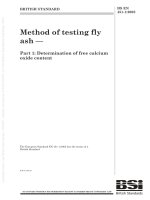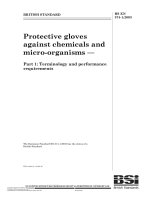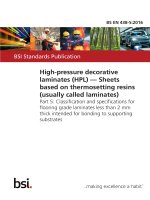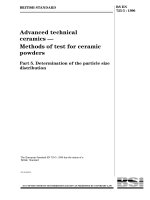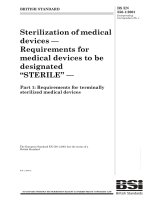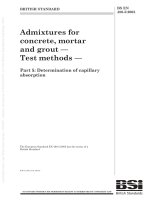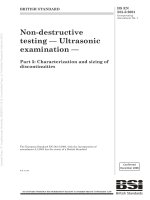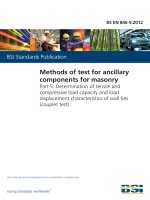Bsi bs en 60747 5 1 2001 (2003)
Bạn đang xem bản rút gọn của tài liệu. Xem và tải ngay bản đầy đủ của tài liệu tại đây (1.21 MB, 32 trang )
BS EN
60747-5-1:2001
BRITISH STANDARD
Discrete semiconductor
devices and integrated
circuits —
Part 5-1: Optoelectronic devices —
General
The European Standard EN 60747-5-1:2001, and the incorporation of
amendment A1:2002 and A2:2002, has the status of a British Standard
ICS 31.260
?? ? ?????? ??????? ??? ?? ???????? ? ?? ? ?? ?? ?? ?????? ? ?? ? ???????? ???
?
?
?
?
?
?
?
?
?
?
Incorporating
Amendments Nos. 1 (to
BS IEC 60747-5-1:1997
renumbering the
BS IEC as
BS EN 60747-5-1:2001)
and 2 and
Corrigendum No. 1
BS EN 60747-5-1:2001
National foreword
This British Standard is the official English language version of
EN 60747-5-1:2001, including amendments A1:2002 and A2:2002, published
by the European Committee for Electrotechnical Standardization (CENELEC).
It is identical with IEC 60747-5-1:1997, including amendments 1:2001
and 2:2002, published by the International Electrotechnical
Commission (IEC).
The start and finish of text introduced or altered by amendment is indicated in
. Tags indicating changes to IEC text carry the number
the text by tags
of the IEC amendment. For example, text altered by IEC amendment 1 is
indicated by
.
From 1 January 1997, all IEC publications have the number 60000 added to
the old number. For instance, IEC 27-1 has been renumbered as IEC 60027-1.
For a period of time during the change over from one numbering system to the
other, publications may contain identifiers from both systems.
??
??
Cross-references
The British Standards which implement international publications referred to
in this document may be found in the BSI Catalogue under the section entitled
“International Standards Correspondence Index”, or by using the “Search”
facility of the BSI Electronic Catalogue or of British Standards Online.
This publication does not purport to include all the necessary provisions of a
contract. Users are responsible for its correct application.
Compliance with a British Standard does not of itself confer immunity
from legal obligations.
Summary of pages
This document comprises a front cover, an inside front cover, the EN title page,
pages 2 to 28, an inside back cover and a back cover.
The BSI copyright notice displayed in this document indicates when the
document was last issued.
This British Standard, having
been prepared under the
direction of the
Electrotechnical Sector Board,
was published under the
authority of the Standards
Board and comes
into effect on
15 January 1998
© BSI 16 January 2003
Amendments issued since publication
Amd. No.
Date
13341
24 December 2001 Implementation of the European
Standard. Also, see national foreword.
13793
17 July 2002
14097
16 January 2003 See national foreword
Corrigendum No. 1
ISBN 0 580 29146 4
Comments
Implementation of CENELEC
amendment A1
EN 60747-5-1
EUROPEAN STANDARD
NORME EUROPÉENNE
EUROPÄISHCE NORM
July 2001
+ A1
February 2002
+ A2
May 2002
ICS 31.260
English version
Discrete semiconductor devices and integrated circuits —
Part 5-1: Optoelectronic devices — General
(includes amendments A1:2002 + A2:2002)
(IEC 60747-5-1:1997 + A1:2001 + A2:2002)
Dispositifs discrets à semiconducteurs et circuits
intégrés —
Partie 5-1: Dispositifs optoélectroniques —
Généralitiés
(inclut les amendements A1:2002 + A2:2002)
(CEI 60747-5-1:1997 + A1:2001 + A2:2002)
Einzel-Halbleiterbauelemete und integrierte
Schaltungen —
Teil 5-1: Optoelektronische Bauelemente —
Allgemeines
(enthält Änderungen A1:2002 + A2:2002)
(IEC 60747-5-1:1997 + A1:2001 + A2:2002)
This European Standard was approved by CENELEC on 2000-12-01.
Amendment A1 was approved by CENELEC on 2002-02-01. Amendment A2
was approved by CENELEC on 2002-05-01. CENELEC members are bound to
comply with the CEN/CENELEC Internal Regulations which stipulate the
conditions for giving this European Standard the status of a national standard
without any alteration.
Up-to-date lists and bibliographical references concerning such national
standards may be obtained on application to the Central Secretariat or to any
CEN member.
This European Standard exists in three official versions (English, French,
German). A version in any other language made by translation under the
responsibility of a CENELEC member into its own language and notified to the
Central Secretariat has the same status as the official versions.
CENELEC members are the national electrotechnical committees of Austria,
Belgium, Czech Republic, Denmark, Finland, France, Germany, Greece,
Iceland, Italy, Luxembourg, Netherlands, Norway, Portugal, Spain, Sweden,
Switzerland and United Kingdom.
CENELEC
European Committee for Electrotechnical Standardization
Comité Européen de Normalisation Electrotechnique
Europäisches Komitee für Elektrotechnische Normung
Central Secretariat: rue de Stassart 35, B-1050 Brussels
© 2001 CENELEC – All rights of exploitation in any form and by any means reserved worldwide for
CENELEC members.
Ref. No. EN 60747-5-1:2001 + A1:2002 + A2:2002 E
EN 60747-5-1:2001
Foreword
The text of the International Standard
IEC 60747-5-1:1997, prepared by SC 47C, Flat
panel display devices, of IEC TC 47, Semiconductor
devices, was submitted to the Unique Acceptance
Procedure and was approved by CENELEC as
EN 60747-5-1 on 2000-12-01 without any
modification.
This standard should be read jointly with
IEC 60747-1, EN 62007-1 and EN 62007-2.
The following dates were fixed:
— latest date by which the
EN has to be implemented
at national level by
publication of an identical
national standard or by
endorsement
(dop) 2002-01-01
— latest date by which the
national standards
conflicting with the EN
have to be withdrawn
(dow) 2004-01-01
Foreword to amendment A2
The text of document 47E/208/FDIS, future
amendment 2 to IEC 60747-5-1:1997, prepared by
SC 47E, Discrete semiconductor devices, of
IEC TC 47, Semiconductor devices, was submitted
to the IEC-CENELEC parallel vote and was
approved by CENELEC as amendment A2 to
EN 60747-5-1:2001 on 2002-05-01.
The following dates were fixed:
— latest date by which the
amendment has to be
implemented at national
level by publication of an
identical national standard
or by endorsement
(dop) 2003-02-01
— latest date by which the
national standards
conflicting with the
amendment have to be
withdrawn
(dow) 2005-05-01
Annexes designated “normative” are part of the
body of the standard. Annexes designated
“informative” are given for information only. In this
standard, Annex ZA is normative and Annex A is
informative. Annex ZA has been added by
CENELEC.
Foreword to amendment A1
The text of amendment 1:2001 to the International
Standard IEC 60747-5-1:1997, prepared by SC 47E,
Discrete semiconductor devices, of IEC TC 47,
Semiconductor devices, was submitted to the
Unique Acceptance Procedure and was approved by
CENELEC as amendment A1 to EN 60747-5-1:2001
on 2002-02-01 without any modification.
The following dates were fixed:
— latest date by which the
amendment has to be
implemented at national
level by publication of an
identical national standard
or by endorsement
(dop) 2003-02-01
— latest date by which the
national standards
conflicting with the
amendment have to be
withdrawn
(dow) 2005-02-01
2
© BSI 16 January 2003
EN 60747-5-1:2001
Contents
Page
Foreword
2
Introduction
4
1
Scope
4
2
Normative references
4
3
Physical concepts
4
3.1 (Electromagnetic) radiation
4
3.2 Optical radiation
4
3.3 Visible radiation
4
3.4 Infrared radiation
4
3.5 Ultraviolet radiation
4
3.6 Light
4
3.7 Photoelectric effect
4
4
Types of devices
5
4.1 Semiconductor optoelectronic device
5
4.2 Semiconductor photoemitter
5
4.3 Semiconductor laser
5
4.4 Light-emitting diode (LED)
5
4.5 Infrared-emitting diode (IRED)
5
4.6 (Semiconductor) photosensitive device
5
4.7 (Semiconductor) photoelectric detector
5
4.8 (Semiconductor) photoresistor,
photoconductive cell
5
4.9 Photoelement, photovoltaic cell
5
4.10 Photodiode
5
4.11 Phototransistor
5
4.12 Photothyristor
5
4.13 Photocoupler, optocoupler
5
5
General terms
6
5.1 Optical axis
6
5.2 Optical port (of a semiconductor
optoelectronic device)
6
5.3 (Optical) cladding
10
6
Terms related to ratings and
characteristics
10
6.1 General
10
6.2 Photoemitters
11
6.3 Photosensitive devices
18
6.4 Photocouplers, optocouplers
21
Annex A (informative) Cross references index 27
Annex ZA (normative) Normative references to
international publications with their
corresponding European publications
28
© BSI 16 January 2003
Page
Figure 1a — Device with bare fibre pigtail
7
Figure 1b — Device with fibre pigtail connector
attached
7
Figure 2a — Device with window, but without
lens
8
Figure 2b — Detector with window, but without
lens (chip referenced)
8
Figure 2c — Detector with lens
9
Figure 2d — IRED with optical port that is not
located on the output window of the package
9
Figure 3 — Non-packaged devices (emitter or
detector) without pigtail
10
Figure 4 — Switching times
11
Figure 5 — Threshold current of a laser diode 13
Figure 6 — Radiation diagram and related
characteristics
14
Figure 7 — Spectral characteristics of
light-emitting diodes and infrared-emitting
diodes
15
Figure 8 — Spectral characteristics of laser
diodes and laser-diode modules
15
Figure 9 — Side-mode suppression ratio
17
Figure 10 — Emission source of a laser diode
18
Figure 11 — Fibre-input sensitivity SFD
19
Figure 12 — Sensitivity diagram and related
characteristics
20
Figure 13 — Multiplication factor of an
avalanche diode
21
Figure 14 — Time intervals of the test voltage 24
3
EN 60747-5-1:2001
?
Introduction
This part of IEC 60747 provides basic information on semiconductors:
— terminology;
— letter symbols;
— essential ratings and characteristics;
— measuring methods;
— acceptance and reliability.
?
1 Scope
This Part of IEC 60747 deals with the terminology relating to the semiconductor optoelectronic devices.
2 Normative references
The following normative documents contain provisions which, through reference in this text, constitute
provisions of this part of IEC 60747. At the time of publication, the editions indicated were valid. All
normative documents are subject to revision, and parties to agreements based on this part of IEC 747 are
encouraged to investigate the possibility of applying the most recent editions of the normative documents
indicated below. Members of IEC and ISO maintain registers of currently valid International Standards.
IEC 60050(731):1991 , International Electrotechnical Vocabulary (IEV) — Chapter 731: Optical fibre
communication.
IEC 60050(845):1987 , International Electrotechnical Vocabulary (IEV) — Chapter 845: Lighting.
IEC 60664-1:1992 , Insulation coordination for equipment within low-voltage systems — Part 1: Principles,
requirements and tests.
3 Physical concepts
(IEV 845-01-01)
1) Emission or transfer of energy in the form of electromagnetic waves with the associated photons.
2) These electromagnetic waves or these photons.
3.2 Optical radiation (IEV 845-01-02)
Electromagnetic radiation of wavelengths lying between the region of transition to X-rays (? 1 nm) and the
region of transition to radio waves (? 1 nm).
3.3 Visible radiation (IEV 845-01-03)
Any optical radiation capable of causing a visual sensation directly.
3.1 (Electromagnetic) radiation
NOTE There are no precise limits for the spectral range of visible radiation since they depend upon the amount of radiant power
available and the responsivity of the observer. The lower limit is generally taken between 360 nm and 400 nm and the upper limit
between 760 nm and 830 nm.
(IEV 845-01-04, specialized)
Optical radiation for which the wavelengths are longer than those for visible radiation.
3.5 Ultraviolet radiation (IEV 845-01-05, specialized)
Optical radiation for which the wavelengths are shorter than those for visible radiation.
3.6 Light (IEV 845-01-06, without note 2 which is not relevant)
3.6.1 Perceived light (see IEV 845-02-17)
3.6.2 Visible radiation (see IEV 845-01-03)
3.4 Infrared radiation
NOTE Concept 2 is sometimes used for optical radiation extending outside the visible range, but this usage is not recommended.
(from IEV 845-05-33: photoelectric detector)
Interaction between optical radiation and matter resulting in the absorption of photons and the consequent
generation of mobile charge carriers, thereby generating an electric potential or current, or a change in
electrical resistance, excluding electrical phenomena caused by temperature changes.
3.7 Photoelectric effect
4
© BSI 16 January 2003
EN 60747-5-1:2001
4 Types of devices
4.1 Semiconductor optoelectronic device
1) A semiconductor device that emits or detects or that is responsive to coherent or non-coherent optical
radiation.
2) A semiconductor device that utilizes such radiation for its internal purposes.
4.2 Semiconductor photoemitter
A semiconductor optoelectronic device that directly converts electric energy into optical radiant energy.
4.3 Semiconductor laser
4.3.1 (Semiconductor) laser diode
A semiconductor diode that emits coherent optical radiation through stimulated emission resulting from
the recombination of free electrons and holes when excited by an electric current that exceeds the threshold
current of the diode.
NOTE The laser diode is mounted on a submount or in a package with or without coupling means (e.g. lens, pigtail).
4.3.2 Laser-diode module
A module containing, together with the laser diode, means for an automatic optical and/or thermal
stabilization of the radiant output power.
4.4 Light-emitting diode (LED)
A semiconductor diode, other than a semiconductor laser, capable of emitting visible radiation when excited
by an electric current.
4.5 Infrared-emitting diode (IRED)
A semiconductor diode other than a semiconductor laser capable of emitting infrared radiation when
excited by an electric current.
4.6 (Semiconductor) photosensitive device
A semiconductor device that utilizes the photoelectric effect for detection of optical radiation.
4.7 (Semiconductor) photoelectric detector
A semiconductor device that utilizes the photoelectric effect for detection of optical radiation.
4.8 (Semiconductor) photoresistor, photoconductive cell (IEV 845-05-37, specialized)
A semiconductor photoelectric detector that utilizes the change of electric conductivity produced by the
absorption of optical radiation.
4.9 Photoelement, photovoltaic cell (IEV 845-05-38)
A photoelectric detector that utilizes the electromotive force produced by the absorption of optical radiation.
4.10 Photodiode (IEV 845-05-39)
A photoelectric detector in which a photocurrent is generated by absorption of optical radiation in the
neighbourhood of a PN junction between the semiconductors, or of a junction between a semiconductor and
a metal.
4.11 Phototransistor
A transistor in which the current produced by the photoelectric effect in the neighbourhood of the
emitter-base junction acts as base current, which is amplified.
4.12 Photothyristor
A thyristor that is designed to be triggered by optical radiation.
4.13 Photocoupler, optocoupler
A semiconductor optoelectronic device designed for the transfer of electrical signals by utilizing optical
radiation to provide coupling with electrical isolation between the input and the output.
© BSI 16 January 2003
5
EN 60747-5-1:2001
?4.13.1
DC input photocoupler/optocoupler
photocoupler/optocoupler consisting at the input of an optoelectronic emitter to which d.c. current is
applied.
4.13.2 AC input photocoupler/optocoupler
photocoupler/optocoupler consisting at the input of an antiparallel optoelectronic emitter to which a.c.
current is applied.
4.13.3 phototransistor photocoupler/optocoupler
photocoupler/optocoupler whose photosensitive element is a phototransistor.
NOTE A base terminal may or may not be provided.
4.13.4 photodarlington photocoupler/optocoupler
photocoupler/optocoupler whose photosensitive element is a Darlington phototransistor.
NOTE A base terminal may or may not be provided.
4.13.5 photothyristor photocoupler/optocoupler
photocoupler/optocoupler whose photosensitive element is a photothyristor.
NOTE A gate terminal may or may not be provided.
4.13.6 phototriac photocoupler/optocoupler
photocoupler/optocoupler whose photosensitive element is a phototriac.
4.13.7 IC photocoupler/optocoupler
photocoupler/optocoupler whose photosensitive element is a photodiode/transistor and an integrated
circuit.
4.13.8 FET photocoupler/optocoupler
photocoupler/optocoupler with one or more field-effect transistors (FETs) in its output stage.
NOTE A FET is activated by photo-elements or by direct optical radiation.
4.13.9 photodiode photocoupler/optocoupler
photocoupler/optocoupler whose photosensitive element is a photodiode.
4.13.10 IC input photocoupler/optocoupler
?
photocoupler/optocoupler whose input elements consist of an integrated circuit and an opto-electronic
emitter.
5 General terms
5.1 Optical axis
A line about which the principal radiation or sensitivity pattern is centered.
NOTE Unless otherwise stated, the optical axis coincides with the direction of maximum radiation or sensitivity.
5.2 Optical port (of a semiconductor optoelectronic device)
A geometrical configuration, referenced to an external plane or surface of the device, that is used to specify
the optical radiation emitted from an emitting device or accepted by a detecting device.
NOTE The geometrical configuration shall be specified by the manufacturer by means of geometrical information, e.g.:
— location, shape and size of the area of emission or acceptance;
— angle of emission or acceptance;
— other parameters, e.g. numerical aperture of optical fibre;
— orientation of optical axis.
6
© BSI 16 January 2003
EN 60747-5-1:2001
Examples:
Signification of annotations in the figures:
?
= emission of acceptance angle
= optical port with diameter D
Ref.
= reference locus for the definition of the optical port.
Example I: Devices with pigtail (emitter or detector)
Figure 1a — Device with bare fibre pigtail
Figure 1b — Device with fibre pigtail connector attached
© BSI 16 January 2003
7
EN 60747-5-1:2001
Example II: Packaged devices (emitter or detector), without pigtail
Figure 2a — Device with window, but without lens
Figure 2b — Detector with window, but without lens (chip referenced)
8
© BSI 16 January 2003
EN 60747-5-1:2001
Figure 2c — Detector with lens
Figure 2d — IRED with optical port that is not located on the output window
of the package
© BSI 16 January 2003
9
EN 60747-5-1:2001
Figure 3 — Non-packaged devices (emitter or detector) without pigtail
5.3 (Optical) cladding (IEV 731-02-05)
That dielectric material of an optical fibre surrounding the core.
6 Terms related to ratings and characteristics
6.1 General
6.1.1 Switching times
NOTE The specified lower and upper limit values referred to in concepts 6.1.1.1 , 6.1.1.2 , 6.1.1.3 , 6.1.1.4 , 6.1.1.5 and 6.1.1.6 are
usually 10 % and 90 % of the amplitude of the pulses (see Figure 4).
6.1.1.1 Turn-on delay time td(on)
The time interval between the lower specified value on the leading edge of the applied input pulse and the
lower specified value on the leading edge of the output pulse.
6.1.1.2 Rise time t r
The time interval between the lower specified value and the upper specified value on the leading edge of
the output pulse.
6.1.1.3 Turn-on time ton
The time interval between the lower specified value on the leading edge of the applied input pulse and the
upper specified value on the leading edge of the output pulse.
ton = t d(on) + tr
6.1.1.4 Turn-off delay time td(off)
The time interval between the upper specified value on the trailing edge of the applied input pulse and the
upper specified value on the trailing edge of the output pulse.
NOTE If the turn-off delay time is mainly due to carrier storage (e.g. in the output transistor of a photocoupler), the term “(carrier)
storage time” and the letter symbol t s are in use.
10
© BSI 16 January 2003
EN 60747-5-1:2001
6.1.1.5 Fall time tf
NOTE The time interval between the upper specified value and the lower specified value on the trailing edge of the output pulse.
6.1.1.6 Turn-off time toff
The time interval between the upper specified value on the trailing edge of the applied input pulse and the
lower specified value on the trailing edge of the output pulse.
t off = td(off) + tf
Figure 4 — Switching times
6.2 Photoemitters
6.2.1 Radiant power, luminous flux
6.2.1.1 Radiant power (of a photoemitter) ? e
The radiant power emitted from the optical port of the device.
6.2.1.2 Luminous flux (of a photoemitter) ? v
The luminous flux emitted from the optical port of the device.
© BSI 16 January 2003
11
EN 60747-5-1:2001
6.2.2 Efficacies
6.2.2.1 Radiant power efficacy ? e, ? radiant efficacy (of an infrared-emitting diode or a laser diode)
??
The quotient of the emitted radiant power ?e, by the forward current IF:
? e = ? e /IF
NOTE If no ambiguity is likely to occur, particularly with the term IEV 845-01-54: “radiant efficiency” ? e = ? e/(IF VF), the term may
be shortened to “radiant efficacy” or “efficacy”. This is nearly always possible.
?
6.2.2.2 Radiant intensity efficacy ? ei (of an infrared-emitting diode or a laser diode)
The quotient of the emitted radiant intensity Ie, by the forward current IF:
? ei = Ie/IF
6.2.2.3 Luminous flux efficacy ? v, luminous efficacy (of a light-emitting diode)
The quotient of the emitted luminous flux ?v, by the forward current IF:
? v = ? v/IF
NOTE If no ambiguity is likely to occur, particularly with the terms IEV 845-01-55: “luminous efficacy of a source”
or IEV 845-01-56: “luminous efficacy of a radiation” K = ? v/? e, the term may be shortened to “luminous efficacy” or
“efficacy”. This is nearly always possible.
? v = ? v/(IF . VF),
6.2.2.4 Luminous intensity efficacy ? vi (of a light-emitting diode)
The quotient of the emitted luminous intensity Iv, by the forward current IF:
? vi = Iv/IF
6.2.2.5 Differential radiant power efficacy ? ed, ? d differential radiant efficacy (of an infrared-emitting diode
or a laser diode)
The radiant power efficacy for small-signal modulation:
? ed = d? e /dIF
NOTE 1 If no ambiguity is likely to occur, the shorter term and letter symbol may be used.
NOTE 2 The term “small-signal modulation efficacy” is in use as synonym.
6.2.2.6 Differential radiant intensity efficacy ? eid (of an infrared-emitted diode or a laser diode)
The radiant intensity efficacy for small-signal modulation:
? eid =d Iv/dIF
6.2.2.7 Differential luminous flux efficacy ? vd, ? d differential luminous efficacy (of a light-emitting diode)
The luminous flux efficacy for small-signal modulation:
? vd = d? v/dIF
NOTE 1 If no ambiguity is likely to occur, the shorter term and letter symbol may be used.
NOTE 2 The term “small-signal modulation efficacy” is in use as synonym.
6.2.2.8 Differential luminous intensity efficacy ? vid (of a light-emitting diode)
The luminous intensity efficacy for small-signal modulation:
? vid = dIv/dIF
6.2.2.9 Large-signal radiant power efficacy ? EL, ? L large-signal radiant efficacy (of an infrared-emitting
diode or a laser diode)
The radiant power efficacy for large-signal modulation:
? EL = ?? e/?IF
NOTE If no ambiguity is likely to occur, the shorter term and letter symbol may be used.
12
© BSI 16 January 2003
EN 60747-5-1:2001
6.2.2.10 Large-signal radiant intensity efficacy ? EIL (of an infrared-emitting diode or a laser diode)
The radiant intensity efficacy for large-signal modulation:
? EIL = ?Ie/?IF
6.2.2.11 Large-signal luminous flux efficacy ? VL, ? L large-signal luminous efficacy (of a light-emitting
diode)
The luminous flux efficacy for large-signal modulation:
? VL = ?? v/?IF
NOTE If no ambiguity is likely to occur, the shorter term and letter symbol may be used.
6.2.2.12 Large-signal luminous intensity efficacy ? VIL (of a light-emitting diode)
The luminous intensity efficacy for large-signal modulation:
? VIL = ?Iv/?IF
6.2.3 Cut-off frequency
6.2.3.1 Small-signal (modulation) cut-off frequency fcd, fc (of a photoemitting diode)
The frequency at which, for constant modulation depth of the forward current, the demodulated a.c. optical
radiant power has decreased to 1/2 of its low-frequency value.
6.2.3.2 Large-signal (modulation) cut-off frequency fCL, fc (of a photoemitting diode)
Under consideration.
6.2.4 Threshold current (of a laser diode) I(TH)
The forward current at which the second derivative of the cure showing radiant power ? e versus forward
current IF has its first maximum (see Figure 5).
Figure 5 — Threshold current of a laser diode
6.2.5 Spatial radiation diagram and related characteristics (of a photoemitter)
6.2.5.1 Radiation diagram
A diagram that characterizes the distribution of radiant (or luminous) intensity:
Ie (or Iv) = f(? ) (see Figure 6a and Figure 6b)
NOTE 1 Unless otherwise stated, the distribution of the radiant (or luminous) intensity should be specified in a plane. This plane
includes the mechanical axis z.
NOTE 2 If the radiation pattern has a rotational symmetry of the z axis, the radiation diagram shall be specified for one plane only.
NOTE 3 If the radiation pattern has no rotational symmetry to the z axis, radiation diagrams for various angles ? shall be specified.
Then the x, y and z directions shall be defined by a drawing in the detail specification.
© BSI 16 January 2003
13
EN 60747-5-1:2001
6.2.5.2 Half-intensity angle ?1/2
In a radiation diagram, the angle within which the radiant (or luminous) intensity is greater than or equal
to half of the maximum intensity (see Figure 6b).
6.2.5.3 Misalignment angle ??
In a radiation diagram, the angle between the direction for maximum radiant (or luminous) intensity
(optical axis) and the mechanical axis z (see Figure 6b).
Figure 6a
Figure 6b
Figure 6 — Radiation diagram and related characteristics
6.2.6 Spectral characteristics (of light-emitting diodes and infrared-emitting diodes)
(see Figure 7)
6.2.6.1 Peak-emission wavelength ?p
The wavelength at which the spectral radiant power is a maximum.
6.2.6.2 ? Spectrum
? bandwidth ?
?
The wavelength interval in which the spectral radiant power is greater or equal to half of its maximum
value.
6.2.6.3 (Relative) parasitic radiant power ?e(par) or luminous flux ?v(par)
The value of undesired spectral radiant power (or luminous flux) in two specified wavelength ranges that
lie below and above the peak-emission wavelength, expressed as a percentage of the radiant power (or
luminous flux) at peak-emission wavelength.
NOTE Specified values refer to the maximum value within each of the specified wavelength ranges.
14
© BSI 16 January 2003
EN 60747-5-1:2001
Figure 7 — Spectral characteristics of light-emitting diodes and infrared-emitting diodes
6.2.7 Spectral characteristics (of laser diodes and laser-diode modules) (see Figure 8)
6.2.7.1 Peak-emission wavelength ?p
The wavelength at the peak value of the mode with the maximum spectral radiant power.
6.2.7.2 Spectrum bandwidth ??
The bandwidth that includes all wavelengths at which the radiant power is equal to or greater than a
specified percentage of the power at the peak-emission wavelength.
?
?
NOTE 1 Unless otherwise stated, the specified percentage is 50 %.
NOTE 2 The definition allows peak values lower than the specified percentage to be present within this bandwidth.
?
Figure 8 — Spectral characteristics of laser diodes and laser-diode modules
?
6.2.7.3 Line width ??L
The wavelength interval between those points of an emission line at which the spectral radiant power is
half of its maximum value.
© BSI 16 January 2003
15
EN 60747-5-1:2001
6.2.7.4 Central wavelength ?
The weighted average of the mode wavelengths:
where
?i
is the wavelength
ai is the amplitude
?
?
?
of the ith spectral line with i = 0 for ?p
6.2.7.5 RMS bandwidth ??rms
The RMS bandwidth is defined by the expression:
where
?i
is the wavelength
ai is the amplitude
?
is the central wavelength
?
?
?
of the ith spectral line, with i = 0 for ?p
6.2.7.6 Number of longitudinal modes nm
The number of longitudinal modes within
limits.
? spectrum? bandwidth, including the modes at the band
6.2.7.7 Mode spacing sm
The difference in wavelength for two neighbouring longitudinal modes.
6.2.7.8 Side-mode suppression ratio SMS
The ratio of:
— the radiant power at the peak-emission wavelength ?ep ; to
— the radiant power of the next most intense mode ?es (see Figure 9).
NOTE Side-mode suppression ratio is normally expressed as:
16
© BSI 16 January 2003
EN 60747-5-1:2001
Figure 9 — Side-mode suppression ratio
6.2.7.9 Spectral shift (versus current or temperature) ??c
Under consideration.
6.2.7.10 Input reflection coefficient s11
Under consideration.
6.2.7.11 Radiant power (of a laser chip or submount) ? eoo
See 6.1 of IEC 62007-1.
6.2.8 Emission source (of a laser diode)
6.2.8.1 Emission source width sw
On the facet of the laser diode, in the direction of the major axis, the width within which the radiant
intensity is larger than or equal to a specified percentage of the maximum value (see Figure 10).
NOTE 1 The direction of the major axis is the direction parallel to the PN junction plane.
NOTE 2 Unless otherwise stated, the specified percentage is 50 %.
6.2.8.2 Emission source height s h
On the facet of the laser diode, in the direction of the minor axis, the height within which the radiant
intensity is larger than or equal to a specified percentage of the maximum value (see Figure 10).
NOTE 1 The direction of the minor axis is the direction perpendicular to the PN junction plane.
NOTE 2 Unless otherwise stated, the specified percentage is 50 %.
6.2.8.3 Astigmatism dA
An astigmatism of the emitted radiation that comes from a difference in curvature of the wave front in the
directions of the major and minor axis, respectively, whereby usually the centre of the curvature in the
direction of the major axis is farther behind the facet than in the other direction.
NOTE 1 The astigmatism can be represented by the curvature dA = a – b of a convex virtual emission source (see Figure 10).
NOTE 2 The value of dA is calculated from the difference in position of the focusing lens when the focused beam diameter is
minimum in each of the two directions.
© BSI 16 January 2003
17
EN 60747-5-1:2001
Figure 10 — Emission source of a laser diode
6.2.9 Noise characteristics (of laser diodes)
6.2.9.1 Relative intensity noise RIN
Under consideration.
6.2.9.2 Carrier-to-noise ratio C/N
The quotient of:
— the mean square radiant power at the specified frequency; to
— the mean square radiant power fluctuations normalized to a frequency band of unit width centered on
the carrier frequency.
6.2.9.3 K-factor; mode partition noise
Under consideration.
6.2.10 Additional characteristics (of laser-diode modules)
6.2.10.1 Tracking error
Under consideration.
6.3 Photosensitive devices
6.3.1 Output currents (of a photodiode)
NOTE The subscripts D for dark and P for photo are still under consideration.
6.3.1.1 Reverse current (under optical radiation) IR(H) or IR(e) , IR
The total reverse current when the photodiode is exposed to incident optical radiation.
6.3.1.2 Dark current IR(D)
The reverse current in the absence of incident optical radiation.
6.3.1.3 Photocurrent Ip
That part of the reverse current that is caused by incident optical radiation:
IP = IR(H) – IR(D)
18
© BSI 16 January 2003
EN 60747-5-1:2001
6.3.2 Output currents (of a phototransistor)
6.3.2.1 Collector current (under optical radiation) IC(H) or IC(e) , Ic
The total collector current when the phototransistor is exposed to incident optical radiation.
6.3.2.2 Collector-emitter dark current ICEO
The collector current in the absence of incident optical radiation.
6.3.3 Sensitivity
6.3.3.1 (Diode) sensitivity SD, S (of a photodiode)
The quotient of:
— the photocurrent IP; by
— the irradiance Ee (or illuminance Ev) at the optical port of the photodiode.
SD =
IP
Ee
or
SD =
IP
Ev
NOTE If no ambiguity is likely to occur, the shorter term and letter symbol may be used.
6.3.3.2 (Fibre-input) sensitivity SFD , S (of a photodiode irradiated [illuminated] from the front end of an
optical fibre) (see Figure 11)
The quotient of:
— the photocurrent IP; by
— the radiant power ?e (or luminous flux ?v, emitted from the optical fibre, for specified values of the
radial displacement r and the distance z of the front end of the optical fibre, relative to the optical port
of the photodiode.
SFD =
IP
or
?e
S FD =
IP
?v
NOTE 1 If no ambiguity is likely to occur, the shorter term and letter symbol may be used.
NOTE 2 In specifications, usually curves are given showing SFD as a function of r and z.
Figure 11 — Fibre-input sensitivity S FD
6.3.4 Cut-off frequency (of a photodiode)
6.3.4.1 Small-signal cut-off frequency fcd, fc
The frequency at which, for constant small signal modulation depth of the input radiant power, the
demodulated signal power has decreased to 1/2 of its low-frequency value.
NOTE When, for the measurement of fc, the photocurrent of the photodiode is observed, a 1-to-2 decrease in radiant power
corresponds to a 1-to-2 decrease in photocurrent. Therefore, when the latter is measured as a voltage drop across a load resistance,
the criterion of a 1-to-2 decrease applies also to the voltage, provided the load resistance is small compared with the output resistance
of the photodiode.
© BSI 16 January 2003
19
EN 60747-5-1:2001
6.3.4.2 Large-signal cut-off frequency fCL, fC
The frequency at which, for constant large signal modulation depth of the input radiant power, the
demodulated signal power has decreased to 1/2 of its low-frequency value.
NOTE The note to 6.3.4.1 applies accordingly.
6.3.5 Spatial sensitivity diagram and related characteristics (of photosensitive devices)
6.3.5.1 Sensitivity diagram
A diagram that characterizes the distribution of sensitivity:
S = f(? ) (see Figure 12a and Figure 12b)
NOTE 1 Unless otherwise stated, the distribution of sensitivity should be specified in a plane. This plane includes the mechanical
axis z.
NOTE 2 If the sensitivity pattern has a rotational symmetry to the z axis, the sensitivity diagram shall be specified for one plane
only.
NOTE 3 If the sensitivity pattern has no rotational symmetry to the z axis, sensitivity diagrams for various angles ? shall be
specified. Then the x, y and z directions shall be defined by a drawing in the detail specification.
6.3.5.2 Half-sensitivity angle ?S/2
In a sensitivity diagram, the angle within which the sensitivity is greater than or equal to half of the
maximum sensitivity (see Figure 12b).
6.3.5.3 Misalignment angle ??
In a sensitivity diagram, the angle between the direction for maximum sensitivity (optical axis) and the
mechanical axis z (see Figure 12b).
Figure 12a
Figure 12b
Figure 12 — Sensitivity diagram and related characteristics
6.3.6 Spectral characteristics (of photosensitive devices)
6.3.6.1 Peak-sensitivity wavelength ?p
The wavelength at which the spectral sensitivity is a maximum.
20
© BSI 16 January 2003
EN 60747-5-1:2001
6.3.7 Multiplication factor M (of an avalanche photodiode)
The ratio of:
— the photocurrent under a condition at which carrier multiplication takes place (IR1 at VR1 ); to
— the photocurrent under a condition at which no carrier multiplication takes place (IR2 at VR2 ):
M =
IR1
(see
IR2
Figure 13)
Figure 13 — Multiplication factor of an avalanche diode
6.3.8 Excess noise factor (of an avalanche photodiode)
Under consideration.
6.4 Photocouplers, optocouplers
6.4.1 Current transfer ratio
6.4.1.1 Static value of the (forward) current transfer ratio hF(ctr) , hF
The ratio of the d.c. output current to the d.c. input current, the output voltage being held constant.
NOTE The abbreviation CTR (d.c.) is sometimes used instead of a symbol.
6.4.1.2 Small-signal short-circuit (forward) current transfer ratio hf(ctr) , hf
The ratio of the a.c. output current to the a.c. input current, the output being short-circuited to a.c.
NOTE The abbreviation CTR(a.c.) is sometimes used instead of a symbol.
6.4.2 Cut-off frequency fctr
The frequency at which the modulus of the small-signal current transfer ratio has decreased to 1/ 2 of its
low-frequency value.
6.4.3 Input-to-output capacitance CIO
The total capacitance between all input terminals connected together and all output terminals connected
together.
6.4.4 Isolation resistance RIO
The resistance between all input terminals connected together and all output terminals connected
together.
6.4.5 Isolation voltage
The voltage between any specified input terminal and any specified output terminal.
6.4.5.1 DC isolation voltage VIO
© BSI 16 January 2003
21
EN 60747-5-1:2001
The value of the constant isolation voltage.
6.4.5.2 Repetitive peak isolation voltage VIORM
The highest instantaneous value of the isolation voltage including all repetitive transient voltages, but
excluding all non-repetitive transient voltages.
NOTE A repetitive transient voltage is usually a function of the circuit. A non-repetitive transient voltage is usually due to an
external cause and it is assumed that its effect has completely disappeared before the next non-repetitive voltage transient arrives.
6.4.5.3 Surge isolation voltage VIOSM
The highest instantaneous value of an isolation voltage pulse of short time duration and of specified
waveshape.
? 6.4.6 Photocoupler providing protection against electrical shock
A photocoupler designed to maintain protection against electrical shock after it has been subjected to
operating conditions (safety ratings) that exceed the specified ratings (limiting values) for normal
operation.
6.4.7 Safety ratings (of a photocoupler for reinforced isolation)
Electrical, thermal, and mechanical operating conditions that exceed the specified ratings (limiting values)
for normal operation, and to which the specified safety requirements refer.
6.4.8 Electrical safety requirements (of a photocoupler for reinforced isolation)
Electrical requirements that have to be met and maintained after the photocoupler has been subjected to
the specified safety ratings to ensure protection against electrical shock.
??
NOTE The photocoupler may become permanently inoperative when safety ratings are applied.
6.4.9 Partial discharge (pd)
Localized electrical discharge which occurs in the insulation between input and output terminals of the
photocoupler.
6.4.10 Apparent charge qpd, q
Electrical discharge caused by a partial discharge in the photocoupler.
6.4.11 Threshold apparent charge qpd(TH) , qTH
A specified value of apparent charge that is as small as technically feasible and to which measured values
of the partial-discharge inception voltage or extinction voltage, respectively, refer.
NOTE 1 A threshold apparent charge of 5 pC was found to be a practicable criterion for photocouplers. Smaller values are desirable
but are not viable at this time.
NOTE 2 In actual tests, this criterion applies to the apparent charge pulse with the maximum value.
NOTE 3 The term “specified discharge magnitude” (see 1.3.18.2 of IEC 60664-1) is synonymous with “threshold apparent charge”.
6.4.12 Test voltages (for the partial-discharge test of a photocoupler)
(See Figure 14). All voltages used are a.c. peak voltages.
6.4.12.1 Test voltage Vpd(t) , Vt
The voltage applied during the test period between the input terminals (connected together) and the output
terminals (connected together), respectively, of the specimen under test.
Partial discharge test voltage: Vpd(t)
The isolation voltage applied during the partial discharge test period.
NOTE 1 Specified values of this voltage may be expressed as a multiple of the specified value of the rated isolation voltage or rated
repetitive peak isolation voltage: Vpd(m) = F ? VIOWM or Vpd(m) = F ? VIORM, whichever is higher. Refer to 6.4.12.2 c), multiplying
factor.
NOTE 2 Test voltage, where the apparent charge has to be equal or less than the specified value.
?
22
© BSI 16 January 2003
EN 60747-5-1:2001
? 6.4.12.2 Initial test voltage Vpd(ini), Vini
The test voltage applied during the initial test time tini.
NOTE 1 The initial test voltage is higher than or equal to the test voltage in the second part of the test period in which partial
discharge characteristics are measured; see 6.4.12.3 .
NOTE 2 For method a), the specified value for the initial test voltage is equal to the specified limiting value of the rated impulse
isolation voltage VIOTM.
NOTE 3 For method b), the specified value for the initial test voltage (isolation voltage) is equal to or lower than the specified
limiting value of the rated impulse isolation voltage VIOTM.
a) Initial voltage: Vpd(ini),a; Vini,a (see Table 1 of IEC 60664-1 for minimum voltages, interpolation is
possible.)
The value of the voltage applied at the beginning of the measurement, for a specified time tini, which is
intended to simulate the occurrence of a transient overvoltage.
b) Initial test voltage: Vpd(ini),b ; Vini,b
The isolation test voltage applied between the short-circuited input and the short-circuited output
terminals at routine test [method b)]. A withstand voltage equal to the manufacturer’s rating with a
maximum of VIOTM.
NOTE The equivalent r.m.s. value of an a.c. test voltage may also be used.
c) Multiplying factor: F
At routine test stage:
At sample test stage and after life tests, subgroup 1:
After life tests, subgroups 2 and 3:
F=
F=
F=
1,875
1,6
1,2
NOTE When the test result using the above F factors is certainly affected by testability on, e.g. the device package size, package
leads or the test system, the following F factors can be chosen instead by manufacturer’s decision: F = 1,6, F = 1,2 and F = 1,0
respectively.
6.4.12.3 Apparent charge measuring voltage Vpd(m) , Vm
The test voltage for which apparent charge is measured.
6.4.13 Partial-discharge inception voltage Vpd(i) , Vi
The lowest peak value of an a.c. test voltage at which the apparent charge is greater than the specified
threshold apparent charge, if the test voltage is increased from a lower value where no partial discharge
occurs.
NOTE The equivalent r.m.s. value of an a.c. test voltage may also be used.
6.4.14 Partial-discharge extinction voltage Vpd(e) , Ve
The lowest peak value of an a.c. test voltage at which the apparent charge is smaller than the specified
threshold apparent charge, if the test voltage is reduced from a higher value where such discharge occurs.
NOTE The equivalent r.m.s. value of an a.c. test voltage may also be used.
© BSI 16 January 2003
?
23
